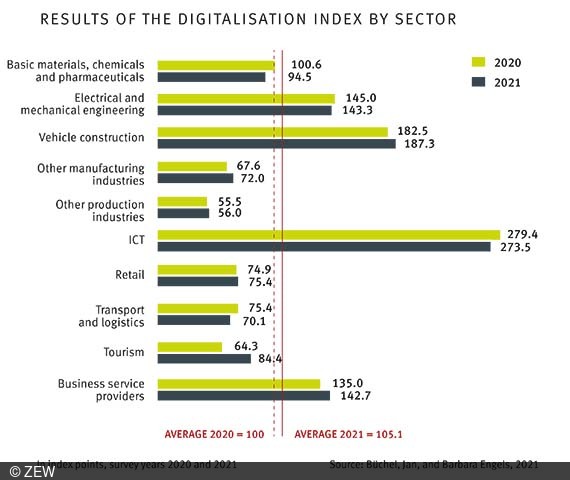German Economy More Digital Thanks to Better General Conditions
ResearchDigitalisation Index 2021
Almost the entire German economy has become more digital than it was in 2020, according to the Digitalisation Index 2021, which is calculated on an annual basis as part of the project “Measuring the degree of digitalisation in the German economy”. The project is conducted by a consortium formed by ZEW Mannheim (consortium leader), the Cologne-based German Economic Institute (IW), IW Consult, the Institute for Industrial Management FIR at RWTH Aachen University, and the German Institute for Economic Research (DIW) on behalf of the Federal Ministry for Economic Affairs and Energy.
The degree of digitalisation in the German economy increased by eight per cent from 2020 to 2021. Improved framework conditions are the main driver of this development. The company-internal categories improve to a lesser extent than the company-external index categories. The category “human capital”, for example, shows a particularly strong increase, as the skills gap in digitalisation occupations has shrunk in the period under review. “This year, the Digitalisation Index was updated for the first time. However, no fundamental shifts were found at the different index levels,” explains Professor Irene Bertschek, head of the ZEW Research Department “Digital Economy”.
The analysis of sector groups showed no significant changes in digitalisation structure. Unsurprisingly, the ICT sector is still very clearly ahead in the sector comparison with 273.5 index points, while the sector average is 105.1 points. However, the sector recorded a slight decline last year, while other sectors were able to catch up, such as vehicle construction, which comes in second place again with 187.3 points. The tourism sector improved particularly strongly, by around 20 index points. Bringing up the rear in the ranking are retail (75.4 points), other manufacturing industries (72.0 points), transport and logistics (70.1 points) and other production industries (56.0 points). However, these sectors have also improved compared to the previous year, with the exception of transport and logistics.
The picture is also mixed at the level of company size. Digitalisation is most advanced in large companies (250 employees or more). Medium-sized companies (50 to 249 employees) have lost some index points compared to the previous year, while both small and large companies have gained some points.
Sorted by federal state groups, the Digitalisation Index shows some differences as well. Of the four groups of federal states – North, East, South, and West – the southern German states of Bavaria and Baden-Württemberg are still leading the field and were able to improve their score the most. The federal state group East, including Berlin, Brandenburg, Mecklenburg-Western Pomerania, Saxony, Saxony-Anhalt and Thuringia, scored lowest compared to the other regions. “The differences in changes of the level of digitalisation between the individual sectors over the last year are not least a consequence of the COVID-19 pandemic, which hit the sectors to varying degrees. Next year’s index will show how trends will have developed,” says Irene Bertschek.

